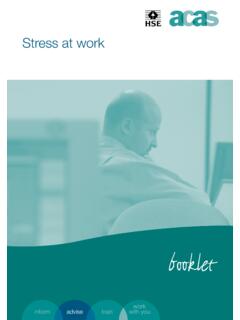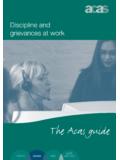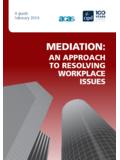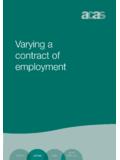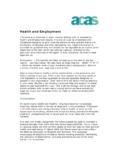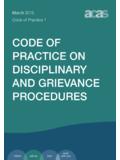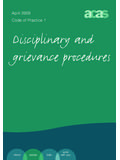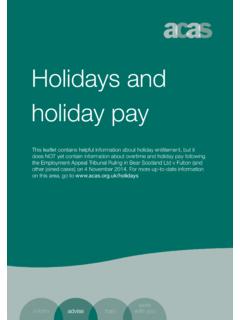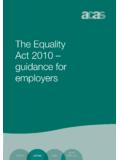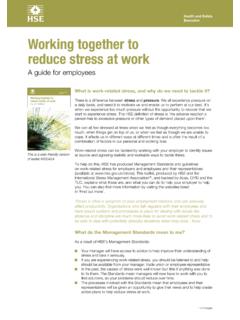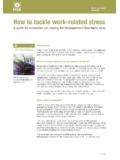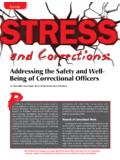Transcription of Stress at work - Home | Acas
1 Stress at work This booklet is intended to assist anyone dealing with Stress at work . It is one of a series of booklets and handbooks designed to give impartial advice on employment matters to employers, employees and their representatives. Legal information is provided for guidance only and should not be regarded as an authoritative statement of the law, which can only be made by reference to the particular circumstances which apply. It may, therefore, be wise to seek legal advice. Information in this booklet has been revised up to the date of the last reprint - see date below. We also have an Acasl Helpline 08457 47 47 47 which can answer most of your questions about employment relations matters including your legal rights and duties. Acas is committed to building better relationships in the workplace and offers training to suit you. From a two-hour session on the key points of new legislation or employing people to courses specially designed for people in your organisation.
2 Click here to find out about training sessions in your area. We also offer hands-on practical help and support to tackle issues in your business with you. This might be through one of our well-known problem-solving services or a programme we have worked out together to put your business firmly on track for effective employment relations. FOREWORD by the Health and Safety Executive Stress is much in the news at present but it isn t a new problem. Pressure is part and parcel of all work and helps to keep us motivated. But excessive pressure can lead to Stress which undermines performance, is costly to employers and can make people ill. HSE estimates that million working days were lost to Stress , depression and anxiety in 2001. Each new case of Stress leads to an average of 29 days off work . work -related Stress costs society about billion every year (at 1995/6 prices).
3 If organisations can reduce Stress they can reduce these costs, and effective management is the best way of doing this. Recent research links effective people management to good performance and productivity. The need to tackle Stress is also recognised in law. Under the Health & Safety at work etc. Act 1974 and the Management of Health and Safety at work Regulations 1999, employers are obliged to undertake a risk assessment for health hazards at work including Stress and to take action to control that risk. However, for many people Stress still represents something of an unknown quantity. HSE has addressed this problem by developing Management Standards to help employers measure their performance in managing the key causes of Stress at work and identify areas for improvement. The Standards look at the demands made on employees; the level of control employees have over their work ; the support employees receive from managers and colleagues; the clarity of an employee s role within the organisation; the nature of relationships at work ; and the way that change is managed.
4 The Standards are based on extensive research. During their development, HSE has consulted widely with employers, employees, trade unions and other interested organisations. HSE is not trying to take the buzz out of work or set impossible targets. The Management Standards approach is about helping and encouraging organisations to continuously improve the way they tackle work -related Stress . HSE is delighted to be working in partnership with Acas. We know that the causes of Stress at work can be alleviated by good management and improved employment relations. Acas has a wealth of practical experience helping employers and employees work together to improve the quality of working life and productivity. Chris Rowe, Head of Stress Policy Team, Health and Safety Executive Introduction The Health and Safety Executive (HSE) define Stress as the adverse reaction people have to excessive pressures or other types of demand placed on them.
5 Recent research shows that this adverse reaction can seriously undermine the quality of people s working lives and, in turn, the effectiveness of the workplace. Stress takes many forms. As well as leading to anxiety and depression it can have a significant impact on an employee s physical health. Research links Stress to heart disease, back pain, headaches, gastrointestinal disturbances and alcohol and drug dependency. This guide aims to help organisations and individuals reduce Stress at work as well as preventing it happening in the first place. This means doing something about the main underlying causes of Stress like poor communication and lack of training and coping with the symptoms of Stress like anxiety and ill health. Policies and behaviour To tackle work -related Stress Acas focuses on the two factors that often determine the nature of the relationship between employers and employees: Policies: the channels we set up for effective communication and consultation and the policies we have for managing the workplace such as written policies for absence and discipline and For further information on the Health and Executive Agency s standards and more detailed guidance on risk assessments, using focus groups and involving managers and employees visit the HSE website at Behaviour: the way that these policies are implemented and the way we behave within the framework of organisational procedures.
6 HSE have identified six main causes of Stress or stressors in organisations. In this booklet we describe how it feels to experience the symptoms of each of these stressors and offer three practical solutions for resolving the stressful situations and preventing future work -related Stress . Some of the solutions overlap. For example, although consultation is not listed until the final chapter on change it is relevant to many of the earlier sections on job design, flexible working and involving staff. Also, while some solutions apply largely to the organisation, others are more concerned with the individual. However, common themes do emerge. These themes such as setting objectives, clear policies, effective communication and working together can help organisations prevent the underlying causes of Stress from emerging. Benefits of tackling Stress There are clear benefits to preventing work -related Stress : quality of working life: employees feel happier at work and perform better management of change introducing a new pay system or new patterns of work are easier when Stress is managed effectively employment relations: problems can be resolved at work rather than at an employment tribunal attendance and sickness: attendance levels go up and sickness absence goes down Not all employers will have the time or resources to follow all of the guidance in this booklet.
7 For example, small firms may not be able to offer counselling to employees or to develop very formal induction systems. However, the principles still apply and all employers should be aware that they have a legal obligation to take work -related Stress seriously. The Health and Safety Executive have the power to act against employers who do not take steps to reach the management standards. For further information on these visit Acas help Acas run training sessions on a variety of subjects in many local areas. These deal specifically with many of the issues like communications and absence that help you tackle Stress at source. Check the training section of our website for more details at Acas also have a network of expert advisers who can help you look in-depth at some of the bigger issues affecting your workplace such as the systems for informing and consulting employees.
8 We also have a helpline which can give information and advice on a wide range of employment relations issues tel: 08457 47 47 47. Acas can help you to achieve the HSE standards (see Appendix 3). We can work with you to secure the commitment of the workforce and to come up with practical solutions to the problems you have identified. Summary Stress is an adverse reaction to excessive pressure or demands. Stress can affect people mentally in the form of anxiety and depression and physically in the form of heart disease, back pain and alcohol and drug dependency. HSE estimate that work -related Stress costs about billion a year. Employers have a legal duty to assess the risk of work -related Stress and to take measures to control these risks. The government aims to work with employers, employees , trade unions and others in achieving a 20% reduction in the incidence of work -relates Stress by 2010.
9 This booklet relates Acas advice to the Health and Safety Executive's six management standards concerned with the main stressors at work . Main causes of Stress : What you can do about it:Demands: employees often become overloaded if they cannot cope with the amount of work or Pay attention to the way the job is designed, training needs and whether it is possible for type of work they are asked to do employees to work more flexible hours Control: employees can feel disaffected and perform poorly if they have no say over how and when they do their work . Think about how employees are actively involved in decision making, the contribution made by teams and how reviewing performance can help identify strengths and weaknesses Support: levels of sick absence often rise if employees feel they cannot talk to managers about issues that are troubling them Give employees the opportunity to talk about the issues causing Stress , provide a sympathetic ear and keep them informed Relationships: a failure to build relationships based on good behaviour and trust can lead to problems related to discipline, grievances and bullying Check the organisation s policies for handling grievances, unsatisfactory performance, poor attendance and misconduct, and for tackling bullying and harassment Role.
10 Employees will feel anxious about their work and the organisation if they don t know what is expected of them Review the induction process, work out an accurate job description and maintain a close link between individual targets and organisational goals Change: change needs to be managed effectively or it can lead to huge uncertainty and insecurity. Plan ahead so change doesn t come out of the blue. Consult with employees so they have a real input, and work together to solve problems Demands: getting the balance right Most employees need a certain amount of challenge and pressure in their work it keeps them motivated and gives them a sense of ambition. However, when does this pressure become stressful rather than stimulating? Employees can feel overloaded by both the: amount of work they are asked to do: they simply cannot do the work in the allotted time difficulty of the work they are asked to do: they are not capable of carrying out the work Each individual is different and only by talking to employees can employers get the balance right between challenging demands and stressful demands.
